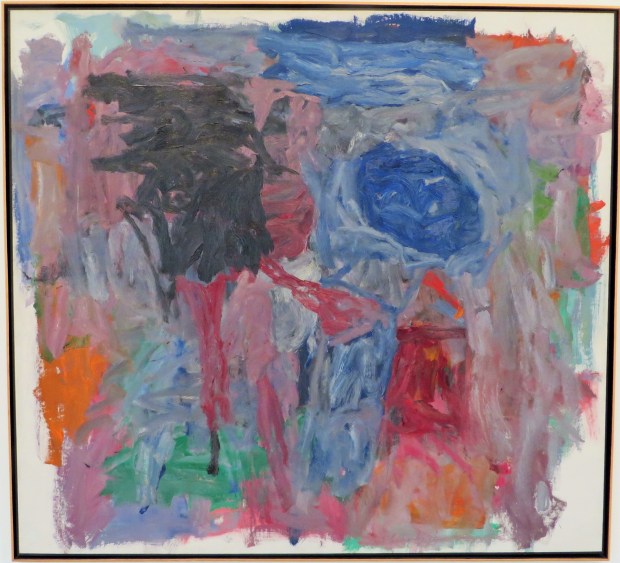
To begin with, intense satisfaction. We knew he got from point A to point B and now we know how and can confirm it by checking the dates to figure out the progression.
Next, an assessment of the individual paintings to see if any of them stand alone. Maybe some of them do, when informed by a sense of when they were made and the part they play. But logically, if they worked, they would have worked for Guston and he would have continued with this abstract/figurative mix, so No. But then again, because they illuminate that battle between abstraction and figuration which is still a question for painting today and because they are suggestive of many other paths he could have taken, then Yes.
In the first two rooms which contain the earlier paintings of this period and which are more colorful, the paintings are overworked and in the second two rooms, the monochromatic paintings are somewhat underdone. In both cases the paintings seem to be given up on. There is a hesitation, a refusal to develop the figurative implications or the abstract possibilities.

In the earlier works, Guston employs the full palette in his own peculiar muddy way. Pure colors are mixed only with black or white except where they collide on the wet canvas. The forms suggest figures outside. People walking? Children playing? A group of women standing?

The later paintings are more like it, as in more like what he came up with even later. They suggest interiors and portraits with either a single head or a few heads and there’s some serious thinking about using the illusion of deep space that Ab-Exers eschewed. Even their general darkness suggests he went deep into his own mind to think about this and it reads as a psychological struggle: How close do I want to be to another person or to a group of people?
The most poignant of the group is the self-portrait or what became the self-portrait. See Painter III above. This is key to Guston’s later work, because “painting himself” (*) became his entry into figurative painting. In what I imagine to be the last thing he did to this painting, he flicked in the hand holding the brush. It’s a singular moment in this very abstract show and it takes a second or two to believe what you’re seeing. I heard Guston loud and clear, standing in front of this painting and saying, “Can I go there?”
Smith and J. Saltz both say in their reviews that Guston did not paint for three years after that. So I guess he thought he couldn’t and then he thought he could.

To return to these later paintings as a group, most of them are scrubbed-on grays over thinly scrubbed-on pink. All of this seems to be a pretext to get to the placement of the black “heads.” I can see lots of possibilities and variations in the gray brushstrokes that could have been developed further, but Guston obviously didn’t and only the “heads” look finished: beautiful, shining, deliberate strokes.
All of the paintings will be familiar to the many painters, both abstract and figurative, who have used this method of laying down paint randomly and unconsciously, searching for the image by painting it. It is improvising– like a jazz musician (perhaps), sometimes with a recurring melody, sometimes not.
But painting in this way is like flipping through a catalog of ideas and can become a death struggle with a succession of NO’s–which doesn’t mean that nothing has been accomplished, quite the contrary, but it feels that way. IF you stay with it AND you can’t not be a painter, at some point there will be a WHY NOT? And a what the hell? And off you go.
Lastly, every art student knows the Guston Story. He changed course, lost his gallery, his collectors and unsurprisingly many artist friends. It’s an inspiration to courage and freedom. And a cautionary tale. There are reasons that artists and other people run with the herd and stay with what’s successful.
It just gets boring, doesn’t it? – CNQ
* “I think a painter has two choices: he paints the world or himself. And I think the best painting that’s done here is when he paints himself, and by himself I mean himself in this environment, in this total situation” Philip Guston 1960
For a great discussion of the show (though I obviously disagree with some of the opinions stated:
http://www.artcritical.com/2016/06/09/roundtable-philip-guston-painter-1957-1967-hauser-wirth/
to read more of What Meets the Eye



